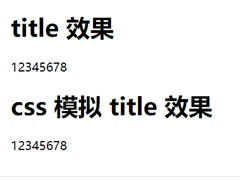CSS中使用grid布局实现一套模板多种布局

如上图,在日常开发中我们可能会遇到对页面进行不同布局配置的需求,实现方法也有很多,例如:
1.写多个页面,不同布局拥有不同的页面模板与样式代码,这种方法看起来是最麻烦也最没必要的,而且布局一但多起来编码会变得十分难受且冗余难以维护,特别当业务代码基本一致时,修改时也会变得繁琐,修改一种布局中的业务代码也要考虑到其他布局,显然这种方式是极其不推荐的。
2.写一个页面,页面内编写多套模板,通过条件控制实现不同布局风格。这种方法相比方法1的好处是使得业务代码可以在一处地方编写,并且相同的部分也只需编写一次,后期业务代码维护起来也变得更加容易。当然,方法1也可以通过引入外部文件实现同一套业务代码。然而这种方法问题在于模板跟样式都要编写几套,如果能只控制模板或只控制样式就可以实现的话无疑是更佳的方案。方法3将详细介绍通过grid布局方法编写一套模板多种样式实现布局布局风格控制。
3.写一个页面,通过grid布局将页面划分为合适的网格单元,即根据多种布局风格统一起来选择一个合适的行列分割数量。
页面模板,按照各种布局中网格数最多的编写(即4个)
<template>
<div :class="['page-wrap', layoutClass]">
<!-- 布局一 -->
<div class="wrap-layout1">
<play-component :loading="loading" :program-info="programsInfo.area1" />
</div>
<!-- 布局二 -->
<div class="wrap-layout2">
<play-component :loading="loading" :program-info="programsInfo.area2" />
</div>
<!-- 布局三 -->
<div class="wrap-layout3">
<play-component :loading="loading" :program-info="programsInfo.area3" />
</div>
<!-- 布局四 -->
<div class="wrap-layout4">
<play-component :loading="loading" :program-info="programsInfo.area4" />
</div>
</div>
</template>
将页面划分为12行12列共144个网格单元

css样式中编写不同布局的行列划分原则
.page-wrap {
//width: 1920px;
//height: 1080px;
width: 100%;
height: 100%;
display: grid;
grid-gap: 1px 1px;
grid-template-columns: repeat(12, 8.333333%);
grid-template-rows: repeat(12, 8.333333%);
position: relative;
background: #FFFFFF;
}
.wrap-layout1,
.wrap-layout2,
.wrap-layout3,
.wrap-layout4 {
background: #D8D8D8;
}
// 默认布局
.layout-default {
.wrap-layout1 {
grid-column: 1 / 13;
grid-row: 1 / 13;
}
.wrap-layout2,
.wrap-layout3,
.wrap-layout4 {
display: none;
}
}
// 布局一
.layout1 {
.wrap-layout1 {
grid-column: 1 / 9;
grid-row: 1 / 13;
}
.wrap-layout2 {
grid-column: 9 / 13;
grid-row: 1 / 5;
}
.wrap-layout3 {
grid-column: 9 / 13;
grid-row: 5 / 9;
}
.wrap-layout4 {
grid-column: 9 / 13;
grid-row: 9 / 13;
}
}
// 布局二
.layout2 {
.wrap-layout1 {
grid-column: 1 / 3;
grid-row: 1 / 13;
}
.wrap-layout2 {
grid-column: 3 / 11;
grid-row: 1 / 13;
}
.wrap-layout3 {
grid-column: 11 / 13;
grid-row: 1 / 13;
}
.wrap-layout4 {
display: none;
}
}
// 布局三
.layout3 {
.wrap-layout1 {
grid-column: 1 / 13;
grid-row: 1 / 3;
}
.wrap-layout2 {
grid-column: 1 / 13;
grid-row: 3 / 13;
}
.wrap-layout3 {
display: none;
}
.wrap-layout4 {
display: none;
}
}
// 布局四
.layout4 {
.wrap-layout1 {
grid-column: 1 / 7;
grid-row: 1 / 7;
}
.wrap-layout2 {
grid-column: 7 / 13;
grid-row: 1 / 7;
}
.wrap-layout3 {
grid-column: 1 / 7;
grid-row: 7 / 13;
}
.wrap-layout4 {
grid-column: 7 / 13;
grid-row: 7 / 13;
}
}
到此这篇关于CSS中使用grid布局实现一套模板多种布局的文章就介绍到这了,更多相关css grid布局内容请搜索脚本之家以前的文章或继续浏览下面的相关文章,希望大家以后多多支持脚本之家!
相关文章
- CSS Grid 是一种二维布局系统,可以同时控制行和列,相比 Flex(一维布局),更适合用在整体页面布局或复杂模块结构中,这篇文章主要介绍了前端CSS Grid 布局详解,需要的朋2025-04-16
- CSS 中的 padding 和 margin 是两个非常基础且重要的属性,它们用于控制元素周围的空白区域,本文将详细介绍 padding 和 margin 的概念、区别以及如何在实际项目中使用它们2025-04-07
- will-change 是一个 CSS 属性,用于告诉浏览器某个元素在未来可能会发生哪些变化,本文给大家介绍CSS will-change 属性详解,感兴趣的朋友一起看看吧2025-04-07
- 本文给大家分享在 CSS 中,去除a标签(超链接)的下划线的几种方法,本文给大家介绍的非常详细,感兴趣的朋友一起看看吧2025-04-07
 在前端开发中,CSS(层叠样式表)不仅是用来控制网页的外观和布局,更是实现复杂交互和动态效果的关键技术之一,随着前端技术的不断发展,CSS的用法也日益丰富和高级,本文将2025-04-07
在前端开发中,CSS(层叠样式表)不仅是用来控制网页的外观和布局,更是实现复杂交互和动态效果的关键技术之一,随着前端技术的不断发展,CSS的用法也日益丰富和高级,本文将2025-04-07css中的 vertical-align与line-height作用详解
文章详细介绍了CSS中的`vertical-align`和`line-height`属性,包括它们的作用、适用元素、属性值、常见使用场景、常见问题及解决方案,感兴趣的朋友跟随小编一起看看吧2025-03-26浅析CSS 中z - index属性的作用及在什么情况下会失效
z-index属性用于控制元素的堆叠顺序,值越大,元素越显示在上层,它需要元素具有定位属性(如relative、absolute、fixed或sticky),本文给大家介绍CSS 中z - index属性的作用2025-03-21- 文章详细介绍了CSS中的打印媒体查询@mediaprint包括基本语法、常见使用场景和代码示例,如隐藏非必要元素、调整字体和颜色、处理链接的URL显示、分页控制、调整边距和背景等2025-03-18

CSS模拟 html 的 title 属性(鼠标悬浮显示提示文字效果)
本文介绍了如何使用CSS模拟HTML的title属性,通过鼠标悬浮显示提示文字效果,通过设置`.tipBox`和`.tipBox.tipContent`的样式,实现了提示内容的隐藏和显示,感兴趣的朋友一起2025-03-10
前端 CSS 动态设置样式::class、:style 等技巧(推荐)
本文介绍了Vue.js中动态绑定类名和内联样式的两种方法:对象语法和数组语法,通过对象语法,可以根据条件动态切换类名或样式;通过数组语法,可以同时绑定多个类名或样式,此外2025-02-26





最新评论